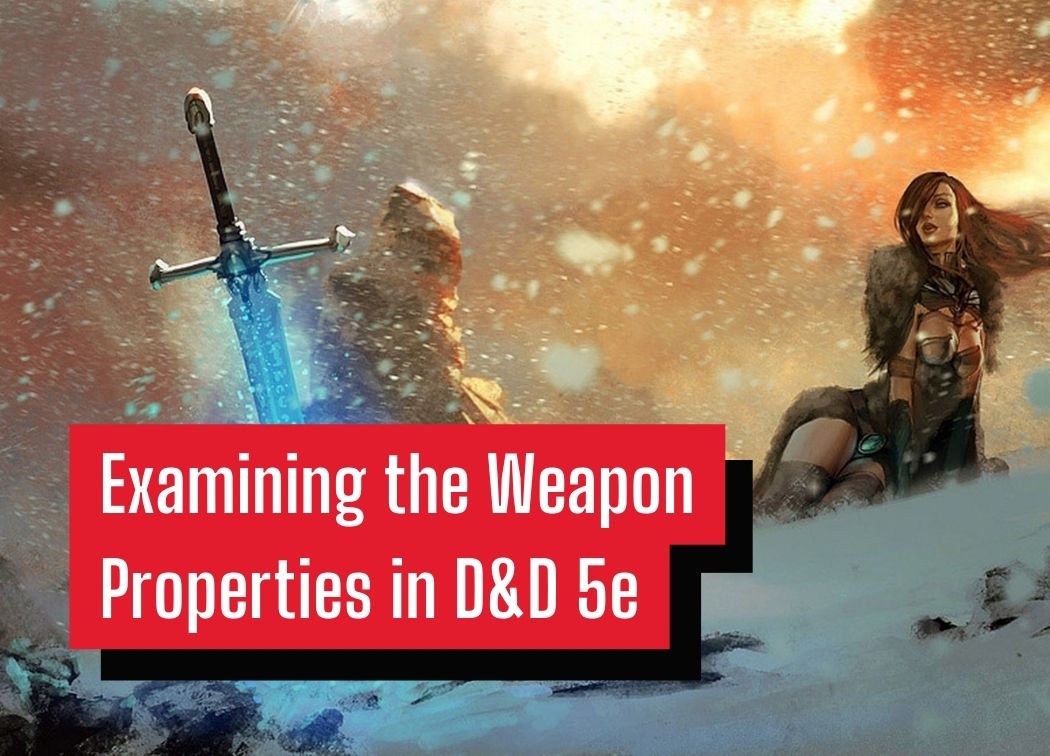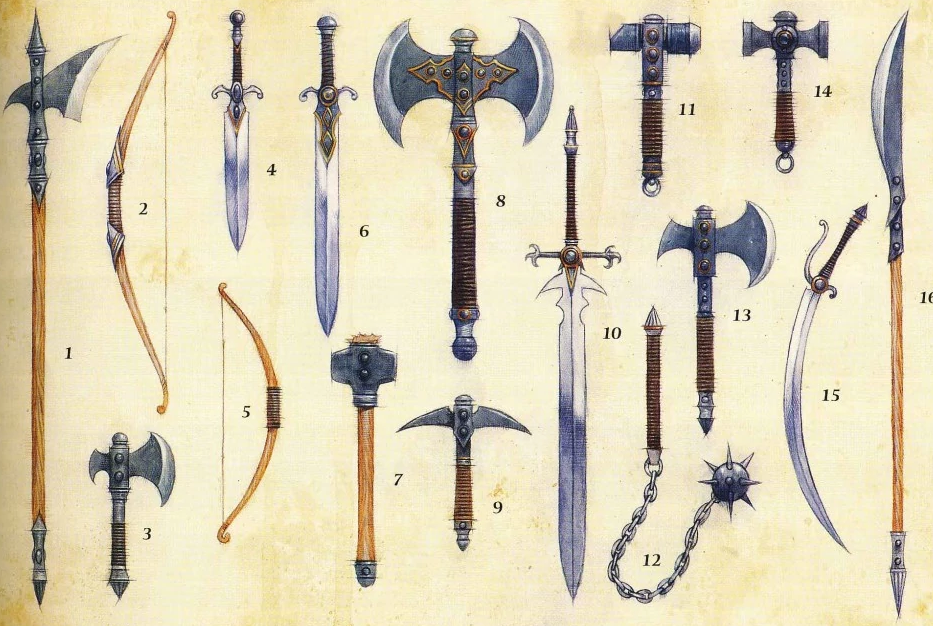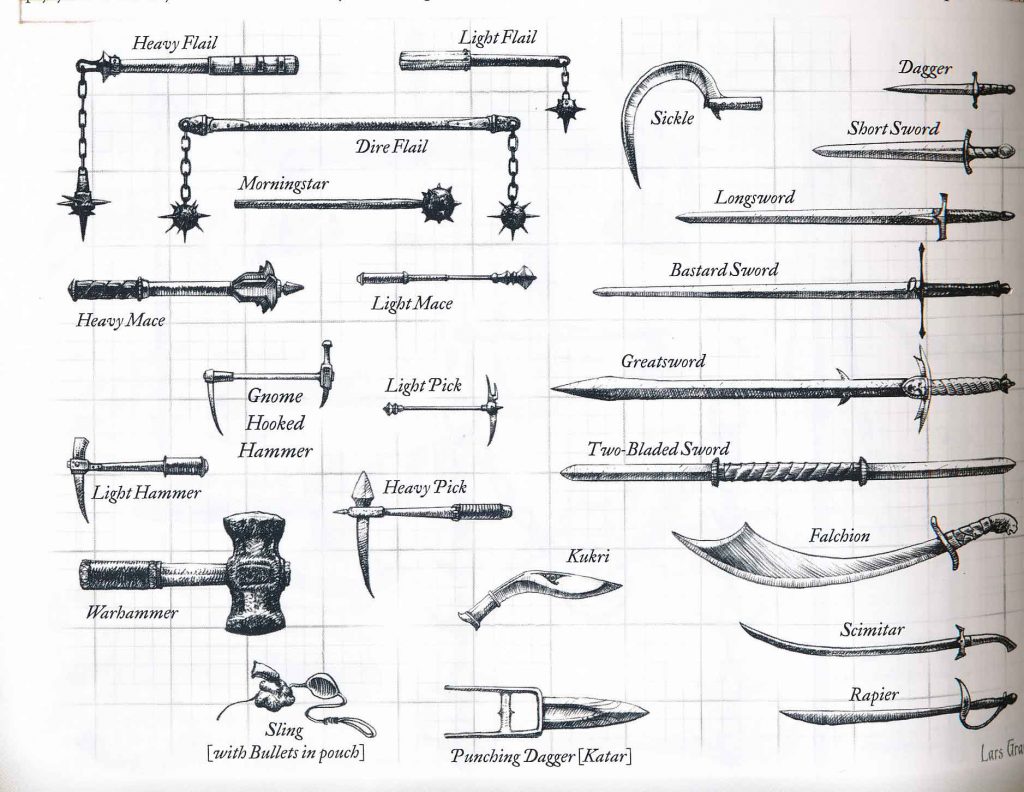Examining the Weapon Properties in D&D 5e

What’s the difference between a shortsword and a longsword? Well, a lot actually, and it’s not just the flavor of the two weapons that separates the two. Both have unique weapon properties that dictate how they can be used in combat.
Weapon properties are just one factor that describes how a weapon is used. Damage, martial vs. simple, and damage type are also indicators that change how weapons are used. Weapon properties are sort of like the flavor that gets added to the weapon.
The combination of all of these factors comes heavily into play when you are purchasing a new weapon or building a new character. Let’s learn about all of the different weapon properties and how they can impact our decision making and our character’s playstyles!

What is a Weapon Property?
In game mechanics terms, a weapon property is a tag on a weapon that adds additional mechanics to the weapon when it’s used. Sometimes these are beneficial properties, other times they can be detrimental.
Knowing what each property does will allow you to select a weapon that either compliments your playstyle or gives you a new playstyle to use in combat.
This decision makes a huge impact on optimizing your character. You can use weapons with certain properties to fill in weak spots or enhance your strengths. For example, a character with low AC may want to choose a one-handed weapon with a shield rather than a two-handed weapon.
Wielding weapons with certain properties can be required to get the most value out of feats. These feats can further change your playstyle or carve an even deeper niche for your character.
Weapon Properties
You can read up on all of the weapon properties on page 147 of the Player’s Handbook (PHB), but I will include a summary of the properties in this article.
General Weapon Properties
Light
This weapon is lightweight and small!
Anyone is able to wield a Light weapon in each hand allowing them to partake in two-weapon fighting. Makes sense. These weapons are small and lightweight enough that you can effectively use them with your offhand.
Light also indicates that these weapons are generally easy to handle. It makes sense, smaller and lighter objects are typically easier to maneuver than their heavy counterparts.
You’ll see a lot of rogues dual wielding Light weapons. This allows melee rogues to have two potential chances at hitting per round rather than their typical one. More attacks mean more chances at landing a Sneak Attack.
Two-handed
You have to wield this weapon with two hands. Shocking, I know.
Typically, weapons that are two-handed will deal a bit more damage than their one-handed counterparts. Logically speaking, this is because they’re generally larger and heavier.
In terms of game design, a Two-handed weapon gives you the perk of a bit extra potential damage in exchange for requiring the use of both of your hands. While wielding a Two-handed weapon doesn’t remove your ability to cast spells, it does mean that you forgo donning a shield.
Is that extra damage worth missing out on +2 AC? That’s for you to decide.
Heavy
Your weapon is bulky, large, and well, Heavy!
The only mechanical effect that Heavy adds to a weapon is that it’s too big for a Small creature to wield effectively. A small creature can wield the weapon, but they will be making attack rolls at disadvantage with it.
You need to be using a weapon that has this property in order to make the -5/+10 power attack from the Great Weapon Master feat.
Fun Fact: Heavy is always included with Two-handed, but Two-handed does not require the weapon to be Heavy.
Special
This weapon does something completely different!
This property varies depending on the weapon that has it. Basically, Special indicates that the weapon has a unique mechanic or modifier that isn’t able to be described by any of the other properties.
Special is not always the same mechanical effect either. For example, the net has the special property which makes a creature restrained if they’re hit by a net attack. On the other hand, the lance has a property that imposes disadvantage on attacks using the lance to attack a target within 5 feet of you.
Special just means “this weapon does something weird. Read the description!”
Thrown
You can throw this weapon!
Weapons with the thrown property can be thrown accurately. If you throw this weapon, you’ll use the same ability modifier (STR or DEX) for it as you would a regular melee weapon attack. If the weapon has Finesse you can choose which modifier you’d like to use even when throwing the weapon.
A weapon that can be thrown will always have the Range property alongside it. We’ll talk more about that property later!
This property is commonly seen on melee weapons that can be accurately thrown, but there are a handful of ranged-only weapons that are Thrown.
Melee Weapon Properties
Finesse
You can use your Strength or your Dexterity modifier for this weapon’s attack and damage rolls.
Actually, that summarizes everything perfectly.
Reach
This weapon has an increased melee weapon attack range.
Your weapon’s reach increases by 5 feet.
Typically this means that you will have a 10 ft. reach with your weapon meaning you can attack a creature within 10 ft. of you. However, there will always be exceptions to this, so the weapon property clearly states that it increases your range.
Versatile
You can wield this weapon with one or two hands.
Wielding the weapon in one hand means that you will use the weapon’s normal damage die when you roll for damage. However, if you choose to wield the weapon in two hands, that damage die will be increased.
This damage increase is typically a single step-up from the weapon’s normal damage die. For example, your weapon deals 1d6 damage as a one-handed weapon or 1d8 damage as a two-handed weapon.
This goes back to my blurb about Two-handed‘s design. Wielding a Versatile weapon in one or two hands is a tactical decision. Do you want extra damage or extra AC from a shield?
Ranged Weapon Properties
Ammunition
This weapon requires ammunition to attack.
In order to use this weapon, you’ll have to have ammunition that you can load into the weapon. Thankfully, drawing the ammunition is part of the attack action so this comes at no cost to your action economy.
Keep in mind that you’ll need to have appropriate ammo for your weapon. You can’t go running around shooting bolts out of shortbows!
You’ll also regain 1/2 of the ammo you used during the battle if you spend one minute searching the battlefield after the combat is over. That is of course if your group bothers with keeping track of ammunition costs or hasn’t acquired a magic item to ignore this mechanic.
Loading
This weapon has some intricate mechanisms and requires time to load it between attacks.
You can only fire one piece of ammunition from this weapon per individual action since you have to spend time reloading the weapon between shots. You’ll also need a free hand to reload the weapon.
This is just one of the reasons why the Crossbow Expert feat is such a strong choice. It allows you to forgo Loading on crossbows, opening up the weapon to characters with the Extra Attack feature.
If there are guns in your campaign you’ll also be super familiar with Loading. It’s a pain in the ass, but generally, it comes with having a higher damage die than ranged weapons without it.
Range (X/Y)
This weapon can hit targets within a certain distance.
Every ranged weapon or weapon with Thrown will have the Range property along with (X/Y). In this case, X is the weapon’s normal range. Y is the weapon’s maximum range. If a weapon is fired further than the X value but less than or equal to the Y value you can make that attack at disadvantage.
For example, a blowgun has (Range 25/100). If you make an attack between 1-25 ft. you will make a regular attack roll. If you make an attack between 26-100 ft. you’ll make the attack roll at disadvantage.
The Sharpshooter feat ignores the disadvantage portion of Range meaning you can shoot from hella far back. It’s just one more reason why that feat is a high-value pickup.
How Do Weapon Properties Impact Weapon Selection?
For me, weapon properties are like decision 1b when selecting a weapon for a character. Unless of course, I’ve specifically built a character around wielding a certain type of weapon.
1a is picking a damage type. Are we hunting a bunch of skeletons? Then yeah we’ll probably go with something that deals bludgeoning damage. We don’t have a ton of chances to deal with vulnerabilities so we should try and make each one count!
It’s important to have a couple of damage type choices for your martial characters. It sucks if they’re going up against something that has resistance or immunity to their primary weapon and they don’t have a solid backup.

Weapon properties unlock new playstyles. So sure, the weapon’s damage type is arguably the most impactful factor in selecting a weapon to use for an encounter. However, certain weapons are going to be more effective in your character’s hands based on your build.
For example, a longsword and a glaive can deal the same amount and type of damage. However, a longsword is Versatile so you can swap between two-handed and sword & board mode, and a glaive has Reach which allows you to strike enemies from afar and take feats like Polearm Master.
Both weapons are suitable choices for a frontline tank build. However, each weapon changes your character’s gameplay significantly.
The best part, though, is that you can absolutely use both. Your glaive may be your specialty, but sometimes you just need to pull out that longsword and get +2 AC by having a shield.
Also, you should always have a ranged weapon option. Even if you’re a master of melee weapons. It’s hard to hit a flying dragon with a greataxe.
Conclusions
Weapon properties add variety and flavor to weapons in D&D 5e. They’re just one way to individualize your character from other characters of the same class. I mean, a fighter that dual-wields is different from a fighter that uses a halberd.
There are games out there where every weapon deals a flat amount of damage and different weapons only exist to provide flavor to the character. For some games that works. D&D is full of combat mechanics so it would feel strange to implement this type of design choice.
Personally, I love having to make choices and decisions that impact the flow of the game. Martial characters usually don’t get a ton of these, so weapon properties are sort of “their thing” that can give them some flavor and playstyle changes.
